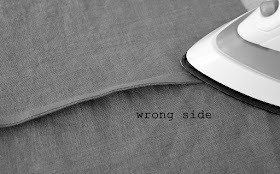So your sleeves are cut and ready, now it's time to cut out the back. When unpicking the jeans don't be tempted to grab the scissors and cut
them apart. There is so much fabric inside the seams and you may need
it.
1. Still working with the first pair unpick the waistband. You need a piece that's wide enough to fit across the back at the waist. Press flat with lots of steam.
2. The upper part of the back is cut from the upper back of the jeans. I've unpicked and taken off the pockets. Place the pattern onto the jean back leaving extra fabric above the fold for a center back seam. Importantly the center back fold and the straight grain on the denim should be aligned. The dotted line indicates the shape of the denim underneath, we'll get to that later. Go ahead and cut it out, DON'T FORGET to add seam allowance above the fold.
3. Now flip your cut piece and using the opposite jean back, cut a mirrored pair.
5. With right sides together stitch the center back seam. Neaten both edges and press the seam open.
6. Place the waistband section you prepared earlier across the back at the waist.
Pin and then stitch along the upper edge following one of the fade lines.
7. As you can see I still have a large section of fabric missing from the lower back, time to fill this in. Unpick the remaining left and right jean fronts and press flat.
8. You need to find enough fabric to cut the lower back from what you have left, you can see now why it's best to buy bigger sizes. In my case I also have to work around a hole and a patch so keep this in mind as well. Join the two fronts together at the side seams making sure the grain lines are parallel.
9. With the excess fabric from the bottom part tucked underneath, place the upper back on top of the lower section so that the center back seams are aligned and using the pattern cut out the lower back.
10. Once you've cut one side move the upper back out of the way and cut the other side to match. You'll notice I've left lots of excess fabric.
11. Using the pattern to position the lower back correctly pin the lower back underneath the waistband and then using one of the fade lines as a guide top stitch in place.
12. Neaten the edges of the upper and lower back cutting away the excess fabric
13. Neaten the side seams cutting away the excess fabric from the waistband. Your back is now complete.
Now it's time to cut the fronts and the ties.























































